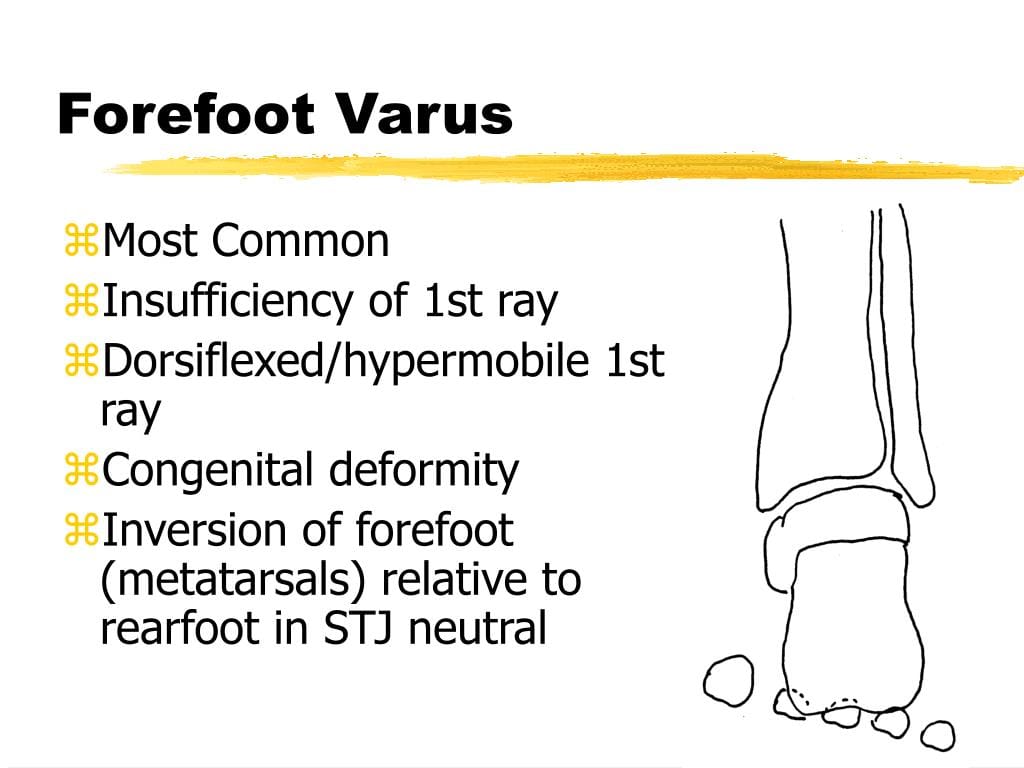What is Forefoot Varus?
Forefoot varus is a congenital, fixed structural deformity where the front part of your foot (forefoot) angles inward compared to your heel. Imagine your forefoot is slightly pigeon-toed, but only in the front. This isn’t a condition that develops over time; you’re born with it, unlike the more flexible forefoot supinatus, which involves soft tissue tightness and can be corrected with stretching and exercises. This subtle misalignment, where the plantar surface of the forefoot is inverted relative to the rearfoot when the subtalar joint is neutral and the midtarsal joint is maximally pronated, can significantly impact the mechanics of your entire foot and may even affect areas further up your leg. One key feature is that the first toe joint sits off the ground in a neutral position.
This inward tilt often forces the rest of your foot to roll inwards excessively when you walk or run, a motion known as overpronation. Think of it like building a house on a slanted foundation – issues are likely to emerge over time. Overpronation can place undue stress on your ankles, knees, hips, and even your spine, potentially leading to discomfort and pain. Over time, this constant strain may increase the risk of developing arthritis. Forefoot varus affects approximately 1-2% of people with forefoot pathomechanical problems. Although less common compared to other foot issues, proper management is essential to prevent long-term consequences. While it’s present at birth (congenital) usually due to a bony block in the mid-tarsal (arch) area, it can also be acquired later in life due to trauma or injury.
Diagnosing Forefoot Varus
Suspect you might have forefoot varus? A simple visual check can offer a clue. Stand barefoot, feet pointing straight ahead. Look at your feet; if the front part seems to be pointing inwards, it’s possible you have forefoot varus. However, a proper diagnosis requires professional evaluation.
A podiatrist will conduct a thorough physical examination, assessing your foot posture and observing your gait. They will look for signs of the inward tilt and resulting overpronation. More specifically, they’ll examine the position of your subtalar and midtarsal joints, key players in foot motion. Applying pressure to the first metatarsal bone (behind your big toe) can help differentiate forefoot varus from the more flexible forefoot supinatus. With varus, the foot remains tilted despite the pressure. If you’re experiencing any foot or leg pain, or suspect a foreign body may be causing an issue, consult a qualified podiatrist and learn more about foreign body removal CPT codes for accurate medical billing.
Managing Forefoot Varus
Since forefoot varus is a structural bone issue, it can’t be “corrected” in the traditional sense. However, its effects are manageable. Custom orthotics (shoe inserts) are the cornerstone of treatment. These orthotics support the forefoot by gently lifting the inner edge, helping to reduce overpronation and distribute weight more evenly. The orthotics typically feature “medial posting,” a raised area on the inner side, to lift and support the tilted forefoot. Sometimes, “flanges,” extensions that offer extra support and reduce friction, are also incorporated. While custom orthotics don’t alter the underlying bone structure, they significantly improve foot function and alleviate symptoms. For optimal results, custom-made orthotics, professionally fitted by a podiatrist, are recommended.
In addition to orthotics, targeted exercises may be recommended to strengthen the muscles in your feet and lower legs, improving foot function and stability. Some experts suggest exercises focusing on strengthening the arches and improving ankle mobility. Always consult with a healthcare professional for personalized exercise recommendations. Appropriate footwear plays a vital role, too. Shoes with good arch support and a wide toe box help distribute weight evenly and allow toes to spread naturally. Avoid high heels or narrow toe boxes, which can exacerbate the condition.
Early intervention is crucial. Addressing forefoot varus promptly can prevent cascading problems in the ankles, knees, and hips. Ongoing research continually explores the complexities of foot mechanics, potentially leading to new insights and treatment approaches in the future. This information is for educational purposes only and doesn’t replace professional medical advice. If you’re a crossword enthusiast, you might enjoy our great plains people crossword.
Key Points to Remember
- Definition: Inward tilt of the forefoot compared to the heel.
- Structural: It’s a fixed bony deformity present at birth, unlike the flexible forefoot supinatus.
- Effects: Overpronation, pain, increased arthritis risk.
- Diagnosis: Physical exam by a podiatrist, including assessing joint positions and a pressure test.
- Treatment: Primarily custom orthotics, possibly supplemented by exercises and proper footwear.
- Early Intervention is Key: Prevent long-term issues in the feet, ankles, knees, and hips.
| Feature | Forefoot Varus | Forefoot Supinatus (Flexible) |
|---|---|---|
| Cause | Bony structural difference | Soft tissue tightness |
| Flexibility | Rigid, fixed | Flexible, correctable |
| Correction | Not possible, managed | Can be corrected |
| Primary Treatment | Custom orthotics | Stretching, exercises |
While forefoot varus is a fixed condition, its effects can be managed effectively to minimize discomfort and prevent potential long-term issues. By combining custom orthotics, targeted exercises, and appropriate footwear, individuals with forefoot varus can likely lead active, pain-free lives. Remember, consulting a podiatrist is essential for accurate diagnosis and a personalized treatment plan. This article provides general information and doesn’t replace a professional consultation. Some experts believe that ongoing research into foot biomechanics may reveal new and more effective treatments.
- Red Cloud, NE: Discover Willa Cather’s Legacy - April 11, 2025
- Remember Old Social Media Sites? Their Rise and Fall - April 11, 2025
- How many days till Feb 3?Accurate Countdowns & Tools - April 11, 2025

















2 thoughts on “Forefoot Varus: Understanding Its Impact, Diagnosis, and Treatment Options”
Comments are closed.